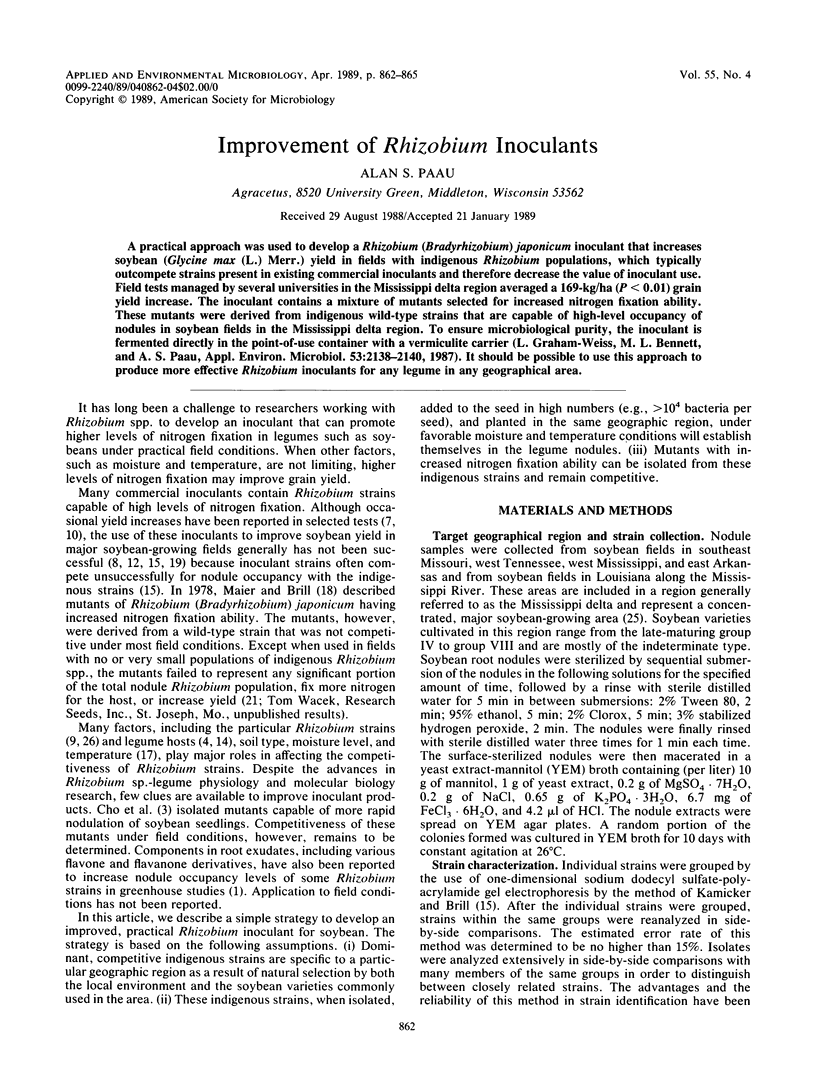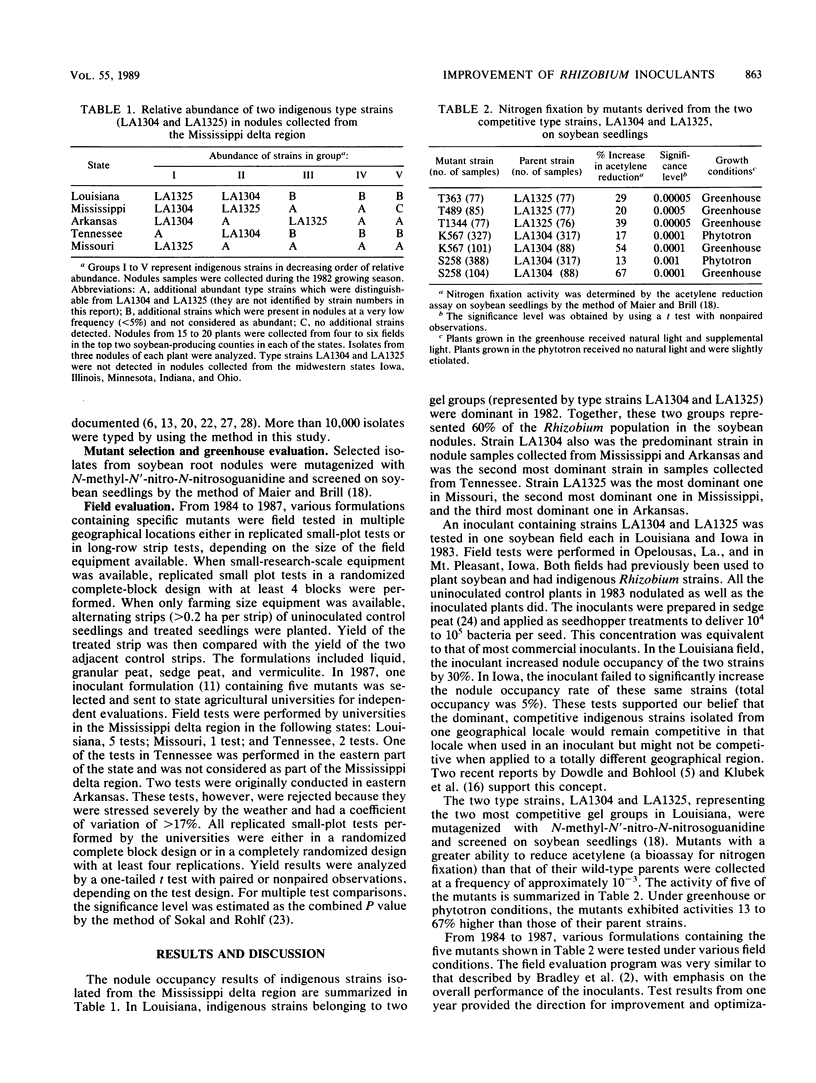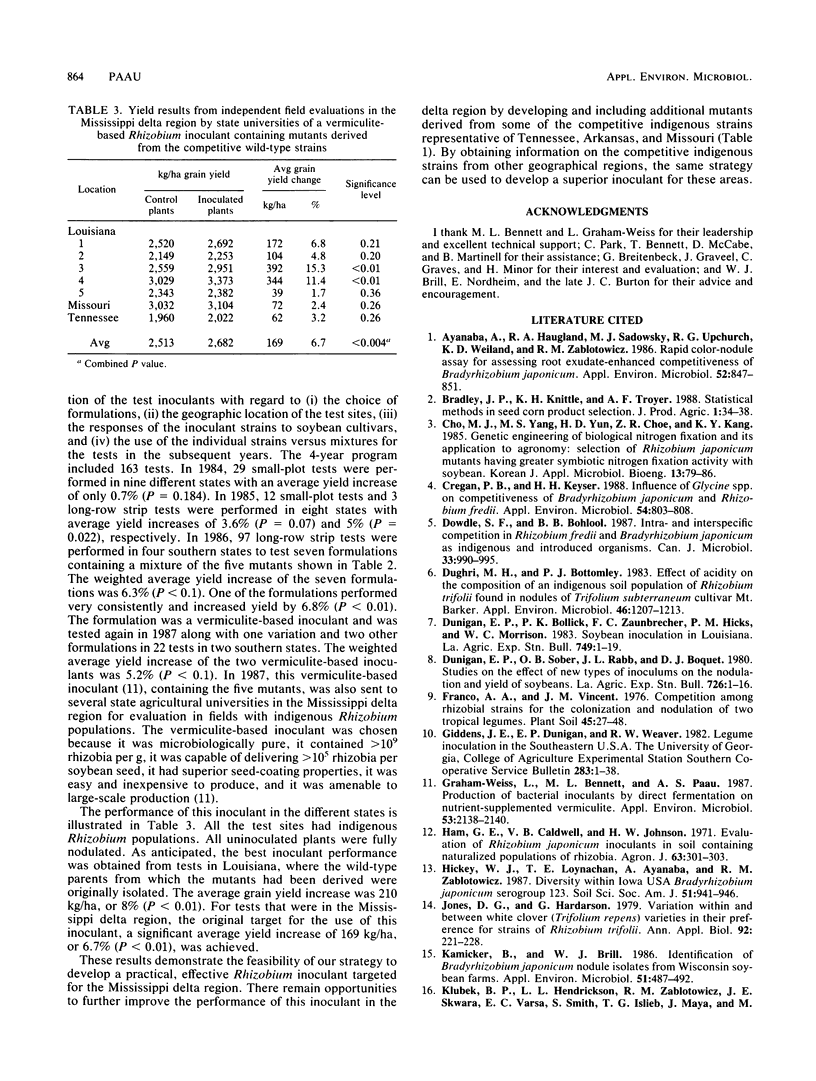Abstract
A practical approach was used to develop a Rhizobium (Bradyrhizobium) japonicum inoculant that increases soybean (Glycine max (L.) Merr.) yield in fields with indigenous Rhizobium populations, which typically outcompete strains present in existing commercial inoculants and therefore decrease the value of inoculant use. Field tests managed by several universities in the Mississippi delta region averaged a 169-kg/ha (P < 0.01) grain yield increase. The inoculant contains a mixture of mutants selected for increased nitrogen fixation ability. These mutants were derived from indigenous wild-type strains that are capable of high-level occupancy of nodules in soybean fields in the Mississippi delta region. To ensure microbiological purity, the inoculant is fermented directly in the point-of-use container with a vermiculite carrier (L. Graham-Weiss, M. L. Bennett, and A. S. Paau, Appl. Environ. Microbiol. 53:2138-2140, 1987). It should be possible to use this approach to produce more effective Rhizobium inoculants for any legume in any geographical area.
Full text
PDF



Selected References
These references are in PubMed. This may not be the complete list of references from this article.
- Ayanaba A., Haugland R. A., Sadowsky M. J., Upchurch R. G., Weiland K. D., Zablotowicz R. M. Rapid Colored-Nodule Assay for Assessing Root Exudate-Enhanced Competitiveness of Bradyrhizobium japonicum. Appl Environ Microbiol. 1986 Oct;52(4):847–851. doi: 10.1128/aem.52.4.847-851.1986. [DOI] [PMC free article] [PubMed] [Google Scholar]
- Cregan P. B., Keyser H. H. Influence of Glycine spp. on Competitiveness of Bradyrhizobium japonicum and Rhizobium fredii. Appl Environ Microbiol. 1988 Mar;54(3):803–808. doi: 10.1128/aem.54.3.803-808.1988. [DOI] [PMC free article] [PubMed] [Google Scholar]
- Dughri M. H., Bottomley P. J. Effect of Acidity on the Composition of an Indigenous Soil Population of Rhizobium trifolii Found in Nodules of Trifolium subterraneum L. Appl Environ Microbiol. 1983 Nov;46(5):1207–1213. doi: 10.1128/aem.46.5.1207-1213.1983. [DOI] [PMC free article] [PubMed] [Google Scholar]
- Graham-Weiss L., Bennett M. L., Paau A. S. Production of bacterial inoculants by direct fermentation on nutrient-supplemented vermiculite. Appl Environ Microbiol. 1987 Sep;53(9):2138–2141. doi: 10.1128/aem.53.9.2138-2141.1987. [DOI] [PMC free article] [PubMed] [Google Scholar]
- Kamicker B. J., Brill W. J. Identification of Bradyrhizobium japonicum Nodule Isolates from Wisconsin Soybean Farms. Appl Environ Microbiol. 1986 Mar;51(3):487–492. doi: 10.1128/aem.51.3.487-492.1986. [DOI] [PMC free article] [PubMed] [Google Scholar]
- Kosslak R. M., Bohlool B. B. Influence of Environmental Factors on Interstrain Competition in Rhizobium japonicum. Appl Environ Microbiol. 1985 May;49(5):1128–1133. doi: 10.1128/aem.49.5.1128-1133.1985. [DOI] [PMC free article] [PubMed] [Google Scholar]
- Maier R. J., Brill W. J. Mutant Strains of Rhizobium japonicum with Increased Ability to Fix Nitrogen for Soybean. Science. 1978 Aug 4;201(4354):448–450. doi: 10.1126/science.201.4354.448. [DOI] [PubMed] [Google Scholar]
- Noel K. D., Brill W. J. Diversity and Dynamics of Indigenous Rhizobium japonicum Populations. Appl Environ Microbiol. 1980 Nov;40(5):931–938. doi: 10.1128/aem.40.5.931-938.1980. [DOI] [PMC free article] [PubMed] [Google Scholar]
- Sadowsky M. J., Tully R. E., Cregan P. B., Keyser H. H. Genetic Diversity in Bradyrhizobium japonicum Serogroup 123 and Its Relation to Genotype-Specific Nodulation of Soybean. Appl Environ Microbiol. 1987 Nov;53(11):2624–2630. doi: 10.1128/aem.53.11.2624-2630.1987. [DOI] [PMC free article] [PubMed] [Google Scholar]
- van Rensburg H. J., Strijdom B. W. Competitive Abilities of Rhizobium meliloti Strains Considered to Have Potential as Inoculants. Appl Environ Microbiol. 1982 Jul;44(1):98–106. doi: 10.1128/aem.44.1.98-106.1982. [DOI] [PMC free article] [PubMed] [Google Scholar]


